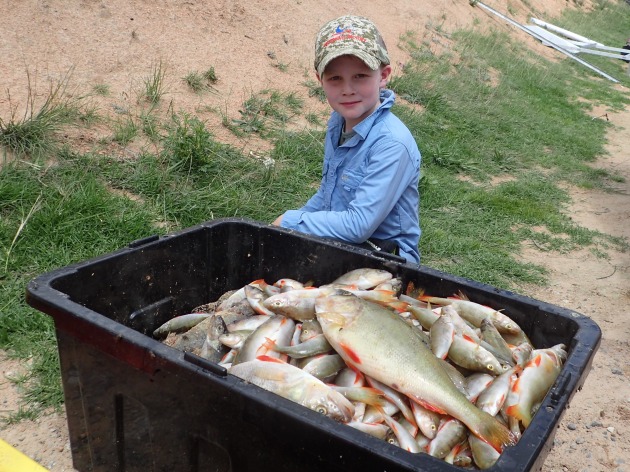October Newsletter from Alex Bellissimo
OPINION: Redfin on the rise
YOU may know these fish as European perch, English perch or just plain redfin. The fact is the highly invasive class one noxious species (in NSW) is fast spreading throughout previously redfin-free waters.
My first introduction to redfin came after the completion of two dams in the Central West of NSW: Burrendong in 1967 and Carcoar Dam in 1970 The colonisation of these two dams was rapid and boat loads of redfin could easily be caught soon after these dams were open to the public. Bobbing was the most popular method of catching redfin as hundreds could be caught in a session.
Balitic Bobbers adorned the wall of many a local garage and barbers shop. Local angler Bill Ryan had a weekly fishing report on Prime TV that consisted mostly of catching redfin in Burrendong Dam.
Of course, worms could always take their fair share of redfin but the bite was so voracious that constantly baiting of the hook was foregone for the ease of a bobber. These were pimped up by some by adding red wool to the hooks.
The ease with which redfin could be caught was a hit with adults and kids alike and it was this willingness to bite that saw unthinking anglers translocate redfin to waters previously free of redfin.
Chifley and Oberon Dams were to many "blue ribbon trout fisheries" and the visiting anglers were numerous. The fishing mags wrote of these two dams with glowing praise.
Oberon was probably better known for its fly fishing, as it was then only bank fishing, whereas Ben Chifley was open to boats and was excellent for trolling and casting.
Redfin were translocated to a farm dam in the catchment above Ben Chifley Dam. A big rain event caused the dam to overflow and the water along with redfin made its way down into the creek that eventually joins the Campbells River and then is captured by the dam itself.
Oberon locals are adamant in their claims that a couple of their own brought a bucket of redfin back from Ben Chifley Dam to put into Oberon Dam so the kids would have something to catch. There are also reports that the dam below the visitors center at Oberon was also stocked by the same anglers.
The effect on trout stocks was a virtual decimation of every trout in the two dams in a very short time. Stocking of trout fry continued with little effect going on catch rates of trout.
While all this was happening in western flowing waters (some water from Oberon Dam is diverted to the east via the Fish River Water Supply) the eastern catchment was still free of redfin.
In 2010 the local newspaper ran a report of another farm dam stocked with redfin, this one in the eastern catchment. NSW Fisheries were quick to act and the redfin were removed, but it would seem the damage had already been done.
This small dam had already spilled over into Coxs River during previous rain events and redfin soon found their way down into Lake Wallace where their numbers exploded. Then Lake Wallace spilled, allowing redfin to move down into Lake Lyell where the numbers have continued to grow rapidly.
It will be of great interest to see how the trout and bass numbers in Lake Lyell stand up to the onslaught of the redfin.
Lake Lyell has also spilled over since the redfin have become established there, so the threat of infestation of Warragamba Dam with redfin is very real and nearly assured.
Wentworth Falls Lake in the Blue Mountains in recent years was also found to have redfin introduced. This lake spills into the Jamison Creek, which joins the Kedumba River and then onto Coxs River.
Many anglers love to target redfin for their fighting abilities, their superb eating qualities and their eager response to lure, fly or bait BUT the act of purposely translocating these fish has caused immense damage. Redfin can carry a virus which has the potential to wipe out our native fish along with our desirable introduced species. Redfin can also rapidly populate a waterway predating on fry and eggs of other species, thus making it redfin only water.
Redfin were recorded as eliminating 20,000 newly released rainbow trout fry from a reservoir in south-western Australia in less than 72 hours. These rapidly breeding fish soon become so numerous that the limited feed and over-crowding often sees the fish succumbing to stunting.
One thousand redfin taken during a recent competition at Lake Lyell.
“Redfin Round Ups” and fishing competitions are focusing more and more on these voracious predators. A recent comp run at Lake Lyell by The Fishing Factory from Orange saw in excess of 1000 redfin caught. While this is a very impressive number it is worth noting that if a thousand redfin were removed every day of the year (365,000 redfin) that equates to less than the number of eggs that two breeding pairs of redfin can spawn in year themselves.
NSW DPI Fisheries are changing the way they are combatting the spread of these voracious predators by stocking larger trout along with ex brood trout instead of fry. This is proving very successful with quite a few trout caught at the recent Recent Redfin Roundup at Oberon Dam, along with a lot of trout again being caught in Carcoar Dam.
Targeting redfin is quite easy. As the weather warms redfin can be easily caught from the bank using bait, lure or fly. During the colder weather the redfin hold deep in the old flooded river beds and deep jigging is the most successful method of getting a feed.
One of the best eating fish going, many out this way refer to the delectable fillets as "bush whiting". Don't get caught with live redfin in your bucket or Esky in your boat as that is risking a fine in NSW.
Read more at http://www.fishingworld.com.au/news/opinion-redfin-on-the-rise#lkbDDWC01U08xKdM.99
Boat Inspection Day: 28th October
iFish kingy recapture
Participate in Mulloway research!
Canberra Fisho's say thanks!
NSW Research Angler Program
NSW Research Angler Program Newsletter
Dear NSW Research Angler,
please find attached the NSW Research Angler Program Newsletter for spring 2017!
On behalf of Fisheries NSW, I would like to thank all of you who participate in the various components of the NSW Research Angler Program for your passion and enthusiasm.
A big thank you to all of the research anglers and spearfishers out there who have donated their mulloway, snapper, tailor, kingfish, pearl perch and dusky flathead frames this past spring.
We had more than 200 frames, heads or jewels donated to the program covering the entire size spectrum of recreationally-caught fish - from 30 cm snapper right up to 133 cm 11 year old mulloway! This information is priceless for researchers who study these iconic recreational fish species.
We had 5 tagged mulloway recaptures, including an 104 cm fish recaptured in the Hawkesbury River which had been tagged 1149 days earlier when just 59.5 cm in length!
Remember, even if it is only one frame, we will do (almost) anything to get it!
Many thanks once again for your involvement in this exciting new approach Fisheries NSW is taking to collect crucial data for NSW’s most popular recreational fish species.
Please don't hesitate to contact me if you wish to discuss any aspect of the program whatsoever.
Thank you again and happy summer fishing for jewies, reddies, kingies, pearlies, macks, duskies and choppers!
Kind regards,
Julian Hughes
Dr Julian Hughes | Research Scientist | Wild Fisheries Unit
NSW Department of Primary Industries | Sydney Institute of Marine Science
Building 19 Chowder Bay Road Mosman NSW 2088 Australia
T: 02 9435 4671 | F: 02 9969 8664 | M: 0411 788 436 | E: Julian.Hughes@dpi.nsw.gov.au
W: www.industry.nsw.gov.au | www.dpi.nsw.gov.au | www.sims.org.au |
AFTA's Marine Park call to action
IN August 2017, the Australian Fishing Trade Association (AFTA) welcomed and supported the plans issues by the Government for the Commonwealth Marine Reserve System. AFTA said it has not waived its support for the Government on this issue.
This week the Government released revised plans that have increased protections on both East and West Coasts Australia. AFTA has consulted with the Australian Recreational Fishing Foundation and the Game Fishing Association of Australia and have determined that these increased protections pose no issue or threat to recreational fishing. AFTA fully endorses the Government's revised Marine Park Plans.
It is highly likely that the Opposition will lodge an Disallowance Motion against the revised plans.
AFTA said industry as a whole and concerned individuals need to make some noise and contact independent and cross-bench members and let them know that the Government’s revised plans for the Commonwealth Marine Reserve System are good for recreational fishers, good for industry and good for Australia.
The Government’s plans present a balanced approach to ensuring our unique marine environment is protected while allowing sustainable recreational fishing access for Australia’s 5 million recreational fishers and the industry behind them.
An AFTA spokesman said: "We are close to seeing these plans become a reality – but only if we can convince Independent and Cross-bench members to supportr the Government's plans rather than the unacceptable Burke plans, which will result in major lockouts all over the country."
What can you do?
- Contact Cross-bench and Independent Members. Their contact details are listed at the bottom of this story.
- Tell them that as both a recreational fisher and a business owner you support the Government’s plans for the Commonwealth Marine Reserves.
AFTA together with the Australian Recreational Fishing Foundation, Game Fishing Association of Australia and Seafood Industry Australia are joining forces on this issue to protect the future of fishing in Australia.



